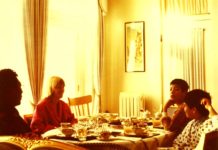Part One:
Part Two:
Part Three:
In this three-part interview, recorded in December 2013, Julia talks with Acharya Adam Lobel about the current Shambhala path of practice and study. For more background information about Adam, listen to Julia’s conversation with Adam Lobel from July 2006.
Readers’ Comments
From Trudee Klautky, 29 October 2014
After listening to the first part of the interview with Adam Lobel I was concerned that the current teaching of close placement and focus on feeling in the body would be confused with the original teachings of Trungpa Rinpoche. It seems more straightforward to acknowledge that things have indeed changed and let the chips fall where they may. As Adam Lobel said at the beginning of the talk, the teachings change all the time to stay fresh.
Trungpa Rinpoches teachings, as far as I’ve seen, from the first foundation of mindfulness through the teachings on the chakras don’t relate to body in this way at all. Most references to body seem to relate to meditation directly, either posture, or synchronizing mind and body through outbreath/gap meditation. Trungpa Rinpoche even went so far as to say that this thing we call a body is merely psychosomatic body and only someone like HH the 16th Karmapa had ‘body/body’. Trungpa Rinpoche usually seemed to laugh off questions about body. When someone asked about their back aching during meditation VCTR said “your personal back?” Or once when someone asked about pain with prostrations Rinpoche said something like “I’m not particularly your vajrayana chiropractor.” This idea of focusing on feeling, or centralizing into your body is very different than the teachings of Trungpa Rinpoche that I have read. By claiming that “nothing has changed” when everything has changed ground, path and fruition this creates a cognitive dissonance that drives some people away, and others who stay cannot even acknowledge what they’ve lost because they are being told they haven’t lost it. And sadly, the new people walking through the door aren’t even given enough to know that the loss of the Kagyu lineage as VCTR presented it is heartbreaking.
I don’t expect anyone to change their view of whether these changes are good or bad but we should at least be clear about the fact that they have happened. At least this much respect is owed to the lineage.
Sincerely,
Trudee Klautky PhD
***
Reply from Adam Lobel, 29 October 2014
Dear Walter, Julia and Joanne,
First, thank you for the interview, and thanks for Chronicles and Mosaics in general. I enjoyed my day with Julia very much and would like more time having honest and intelligent exchanges about the transformations in our lineage.
This comment about meditation and “feeling” is interesting; certainly not the most heated response out there, I am sure! But on this particular point about meditation, feeling, and the body: This is a good example of how opinions and misunderstandings form and congeal quickly when we are not in actual relationship and exchange. The Sakyong’s recent teaching of “feeling” is almost the exact opposite of the “close placement” approach. It is perhaps closer to the Vidyadhara’s earliest and formless instructions on meditation than it is to classic shamatha or modern versions of body-centered awareness. In his writings and teachings on Shambhala Meditation, the Sakyong is explicit that “feeling” is not the same “feeling” as in either tactile sensation nor the second skandha, “feeling” (vedana, tshor ba).
Instead:
“Feeling is the emotional connectivity that leads to the transformative quality of mindfulness. Without feeling, mindfulness can leave one feeling disconnected from oneself, as if it were a tool with which one is performing surgery. This is its mechanical aspect. By contrast, feeling, with its honest and accepting qualities, is the more tactile and emotional aspect of mindfulness. It transforms meditation from a tool that one imposes on oneself into an integrated experience…
When we use the word feeling in Shambhala meditation, we are not simply hoping for the best. Rather, the intuitive nature of feeling means that we can trust the inherent level of goodness within us and experience the totality of our humanity….
With the stage of feeling we: “are contacting ourselves and acknowledging out own humanity…we awaken our sense faculties. We are alive and present; we are sitting here, proclaiming our spot. This allows us to simply feel how we feel…With the gesture of feeling we are realigning our sense faculties with the tuning fork of goodness. Resting our hands on the thighs shows that we value our experience of feelings as the natural expression of our inherent strength, a proclamation of goodness. Each sense faculty is like a ray of light illuminating our goodness. Each sight we see is vivid reminder of our existence. Each sound we hear is like the great conch of goodness being blown. Each taste is a delight and discovery of our world. Each smell brings us into the present moment. Each touch is an intricate texture, interwoven with our aliveness. Extending into the environment, our feelings empower the world.” Sakyong Mipham, Shambhala Meditation: Proclaiming Basic Goodness
And in terms of the overall point of Shambhala Meditation, it is explicitly connected with Shambhala vision:
“By proclaiming a fundamental ground of basic goodness, we create a culture where there is a natural propensity toward basic goodness…
The culture that doubts and fears humanity’s basic goodness will constantly reinforce the feeling of unworthiness. That culture’s bottom line values will constantly telegraph an environment of non-goodness. When we try to meditate within that environment of mistrust and anxiety, we might use meditation as an attempt to numb the anxiety of that discontentment. Or perhaps we will use it to escape boredom, or to create a superficial level of seeming goodness, or to find an alternate state where we can forget about guilt and anxiety, or to fix something in us that we think needs work. These methods, though seemingly beneficial, are all built upon a ground of uneasiness. Ultimately, meditation is about deep relaxation of the mind. However, if that mind feels insecure about basic goodness, then that mind can never truly relax. When it does attempt to relax, it eventually comes to rest in what appears to be the nature of the mind—inadequacy. This inadequacy comes from being brought up in a culture of doubting basic goodness.”
—Sakyong Mipham, Shambhala Meditation: Proclaiming Basic Goodness
In short, the actual instruction on “feeling” is a spacious, open, and gentle awareness without reference point or object. There is no stabilization or emphasis on drawing within, placing the mind on an object, “centralizing on the body,” or doing something like a body scan. It is much more similar to Mahamudra techniques. The view in which each sense perception and each thought and emotion are all understood as the display of basic goodness is of course a very high view indeed (reminiscent of Longchenpa’s teachings), one of total empowerment of the phenomenal world as sacred.
Instructing someone in “feeling” is subtle, requires tremendous gentle acceptance of the totality and tenderness of human experience, and it is certainly not an inward body-focus, as the commentator seems to think. The various descriptions of the sensory experience and the implied “panoramic” awareness should make that clear. This practice has been transformative and helpful for many of us, as it encourages freedom from the manipulation that most of us continue to impose upon our practice, even as vajrayana practitioners.
Shambhala Meditation seems to be a beautiful continuity of the intuition present in the Dorje Dradüls instructions about how to offer Shambhala teachings. Here are notes quoting the Dorje Dradu¨l’s Shambhala Training Director talks on January 3 and 10 of 1978:
“Everybody’s opinions and attitudes about himself are very important in this case. If there is a slightest tendency within you to feel a little bit wretched, inadequate and fundamentally distrustful of yourself, it shows through. That doesn’t mean that you are not allowed to think anything bad about yourself, particularly, but there is another side of you, which is good. It is just a simple attitude to ourselves… That kind of spark, which exists in you, is the seed that we are trying to spread to the rest of the world.
…And the first thought that comes to mind when we think about what we can do with this is some sense of friendliness to ourselves. Some sense of friendliness begins there, that it is worthwhile and you are worthwhile. And some sense of softness to ourselves begins to develop.
…And when we present these things to ourselves, they should be moving rather than a big deal. It is almost like touching the aspect of whatever exists in us, which is positive, but at the same time, slightly sad. Because it is very positive, it’s very tender. So it has to be truly human, you see, a very human kind of thing. So we are talking about a human situation and how to feel like a human being. And the human thing, which exists in us is a kind of positive cervix which is very tender. That seems to be the heart of the Shambhala approach, if you like, that kind of tremendous gentleness. That has been one of the problems of the world, that people don’t feel themselves. So we are trying to feel ourselves from that point of view.
…Well, maybe we could just go straight to your heart. That’s why Shambhala Training should be simpler; we are presenting the whole thing. It’s to make people cry. The approach of hard-core cynicism and everything would be a repetition of the buddhadharma. There’s a different aspect to (inaudible). So the whole presentation of the real warrior way is that the warrior is very gentle.
That is not so much a matter of believing in goodness. Rather if you actually look, take things apart, your mind apart, your whole being apart and examine them and it, you find you are genuine, along with the whole thing. The whole thing is well constructed and there’s no room for mishap of any kind.”
Please feel free to share this with the commentator or online if it would be helpful.
In the Great Eastern Sun,
Adam
***
Hi Adam,
This is our relationship and exchange at this point I’m here. It’s ok if we disagree, and since I’m the only person responding at this point I really am the most heated which isn’t so bad considering the fall chill here! I will try to cook this up again so my misunderstandings don’t congeal.
So, what you are saying is that the description you gave at 22:03 in the interview that says (an approximation of the quote below).
“The instruction is to follow the in breath and the out breath and particularly also to attend to the body breathing, so a lot of emphasis on embodiment, so feeling the body as it’s breathing, following the breath as it moves in and out, there is an emphasis on some sense of space following the breath out and opening into some sense of space and a tremendous emphasis on feeling a willingness to actually feel your present experience whatever that may be”
Because you said this I mentioned close placement (which is what I consider inbreath/outbreath to be). And I mentioned the feeling in the body part because you mentioned “emphasis on embodiment and feeling the body as it’s breathing”. I wasn’t particularly referring to the other feeling teachings which you expounded on in your response.
Unless I am misunderstanding again: are you saying that this instruction of in breath/outbreath is parallel to mahamudra and dzogchen? Is it still being taught by Shambhala guides when we were taught to teach this they called it close placement and did not mention mahamudra at all. In fact I was told not to use the word Luminous when referring to mind because that was “too vajrayana”.
Perhaps it would be more clear to me if you could parse out the meditation techniques a bit more there seem to be multiple techniques all described together and I’m not sure how they relate. I’m certainly no expert on mahamudra and dzogchen teachings and am not trying to argue about skandhas or bhandas here.
Either way I just wanted to say I think the instruction is different not a comment on whether its good or bad but it’s just different. And I’m a bit slow with the intellectual aspects of practice to be honest. The only instruction I ever got in Shambhala back in the day was out breath gap- it is fantastic!!
I also didn’t understand how the quotes you gave related to what I was saying about the basic instructions being different? Was it to explain why the instructions were changed?
Thanks for your time –
Sincerely,
Trudee Klautky PhD
***
Dear Adam and Julia, Thank you so much for this brilliant interview. I have been part of the community for 5 years, and there has certainly been a lot of confusion about the education piece in our sangha. I feel much more confident in being able to express it all, particularly as a Shambhala Guide.
Julia, your questions were very pointed, and I’m thankful for them! I am especially glad you brought up the question of refuge: to take/not take.
In my sangha in Denver, and in my cohort in particular, this question was asked a lot! Many times, it was not always in the presence of a teacher, but among ourselves. The question can go down an intellectual rabbit-hole, but it IS one of the messy questions that gets asked, quite frequently.
I also was struck by your comment of always having an irritant whenever we think we’ve got it right. That is always the case with me, and friends who confide in me. We love/hate Shambhala! I could also extend that out to everyday life, which is interesting, since the levels are teaching about everyday life.
I came to this path probably as a spiritual materialist. I wanted to transcend myself, escape myself, experience bliss beyond all imagination. What I have come to realize is that Shambhala in it’s present form is so much more than that. The Sakyong is a completely different person that his father was, and he is the perfect person for this generation. I feel that he is taking his father’s brilliant charisma and creative magic and is putting legs on it. To me, this lineage will not be about hanging out with the guru, it is about creating enlightened society, and that’s fine with me. I think it is extremely challenging, and not blissful at all, much of the time. I wish with all my heart that I could even meet him, but I know that my path is not about that. I completely trust him, and working with the challenges and joys on this path is enough for me.
I feel that the people coming into our center every week for open house are looking to discover their basic goodness. The ones who ‘get hooked’ discover that, and discover how to make the world a better place. This is a priceless jewel, as old as humanity, and as brilliant as the morning sun.
-Lokken Liane
***
The theme music for Mosaics is from Mussorgsky Pictures at an Exhibition











